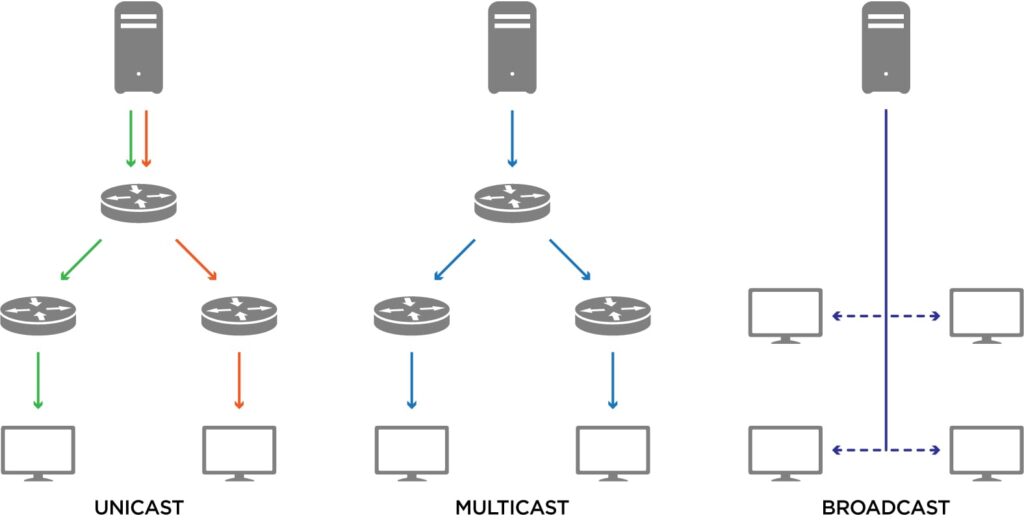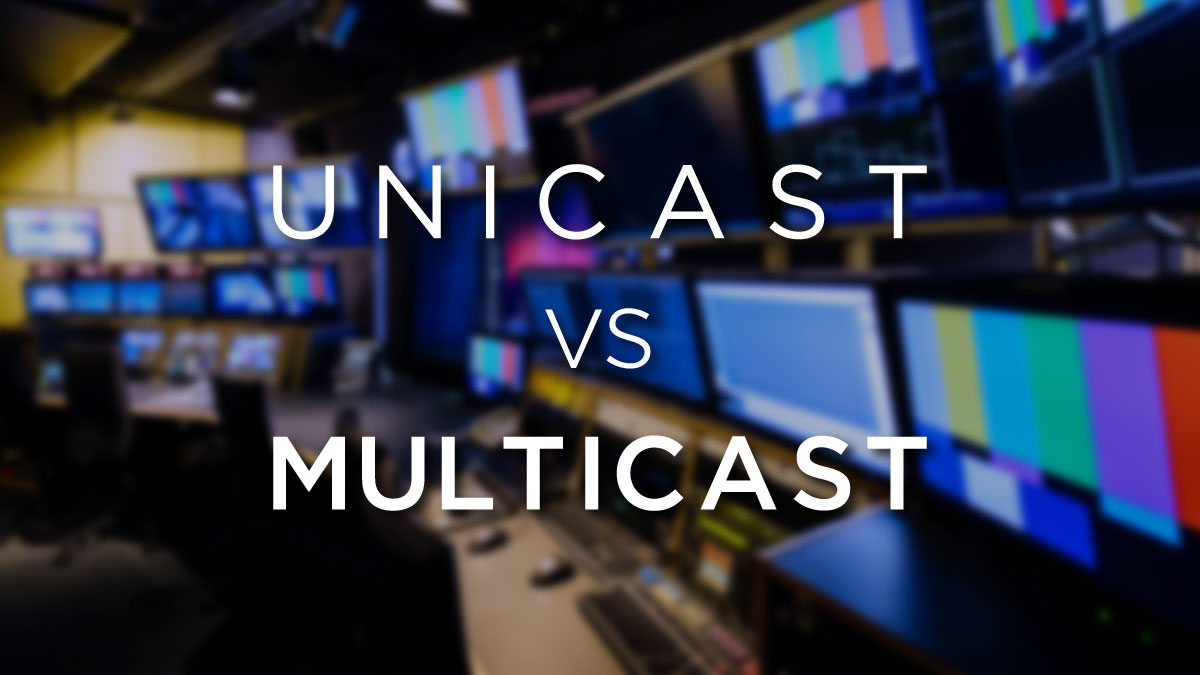Let’s tackle a question that we’re frequently asked when discussing live video streaming and distribution: what are meant by the terms unicast and multicast? This primer will give you a basic overview of the differences between the three most common ways to distribute live video.
One very simple way to remember the difference is one-to-one, one-to-many, and one-to-all. Read on for a more detailed explanation of each.

What is Unicast?
Unicast is a one-to-one connection that delivers streams over the internet. A user requests information from a server, website or another user, and the other party sends it after establishing a unique connection. Unicast is great for on-demand, watch whatever, whenever you want content. OTT or Over the Top services rely on unicast for streaming live video to smartphones, tablets, SmartTVs, and other internet-connected devices.
When delivering a live sporting event via an OTT app, installed on a smartphone, tablet, or smart TV, an origin server is used to live stream content to thousands of individual viewers around the world. Each person watching the live stream has a unique connection between their viewing device and the origin server in unicast mode. As unicast streaming takes place over the internet, network paths and bandwidth availability can vary greatly from stream to stream. As a single origin server may struggle when delivering thousands or even millions of unique unicast streams, Content Distribution Networks (CDN) are used to distribute the streams across the internet and share the load.
What is Multicast?
Multicast is a one-to-many streaming over IP method similar to traditional broadcast. Multicast uses UDP (User Datagram Protocol) for “broadcasting” a stream over a closed IP network such as a LAN (Local Area Network) or an IP Service provider’s own network. Multicast streaming of live TV is commonly referred to as IPTV, whereas OTT is unicast over the internet.
In a multicast IP network, the content sender only needs to deliver a single stream, and the nodes along the network will replicate that stream across the entire network, as in a relay race. Using multicast for distributing video to hundreds or thousands of users is the preferred video delivery option for companies and organizations as it avoids flooding the network with duplicate streams. Multicast is also used for transporting SMPTE ST 2110 video, audio, and metadata streams within a broadcast facility or OB production network.
Where does SRT Fit In?
Whether you’re delivering video via unicast or multicast, ensuring low-latency, secure, and reliable transport is key—especially over unpredictable networks. The Secure Reliable Transport (SRT) protocol, developed and open-sourced by Haivision, addresses these challenges.
SRT is designed for low-latency video transmission across unreliable networks such as the public internet, making it a perfect fit for unicast streaming. It actively mitigates jitter, packet loss, and fluctuating bandwidth, ensuring stream integrity end-to-end. Additionally, Haivision’s SRT Gateway enables organizations to convert streams between unicast and multicast, effectively acting as a bridge to support hybrid workflows across different network infrastructures.
Learn more about SRT Gateway →
What is Haivision Media Platform (HMP)?
For enterprises looking to securely deliver both unicast and multicast video within their organization, Haivision Media Platform (HMP) provides a centralized solution. HMP supports IPTV, corporate communications, all-hands meetings, and more, allowing video content to be shared seamlessly across various networks and devices—whether in-office or remote.
Haivision Media Platform supports multicast for bandwidth-efficient internal streaming and can also deliver unicast video to mobile devices and remote employees. Additionally, with DoDIN APL certification, Haivision Media Platform meets stringent security standards for deployment in defense and government environments.
Learn more about Haivision Media Platform →
Which one is right for my video stream?
While the broadcast one-to-all model continues to serve traditional linear TV, the evolving demands of digital content have given rise to more flexible streaming models.
- Broadcasters may add unicast OTT services to reach global audiences.
- Enterprises may use multicast for internal IPTV and unicast for mobile and remote users.
- Media production teams might leverage SRT and HMP to maintain quality and security across networks.
Ultimately, each method has its role depending on your audience, infrastructure, and content type. Increasingly, organizations are deploying hybrid strategies that combine one-to-one and one-to-many delivery.

